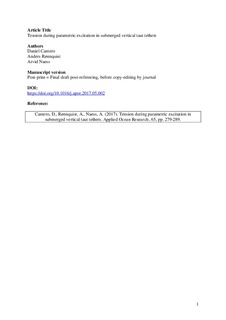| dc.contributor.author | Cantero, Daniel | |
| dc.contributor.author | Rønnquist, Anders | |
| dc.contributor.author | Næss, Arvid | |
| dc.date.accessioned | 2017-05-11T07:34:12Z | |
| dc.date.available | 2017-05-11T07:34:12Z | |
| dc.date.created | 2017-05-09T09:24:53Z | |
| dc.date.issued | 2017 | |
| dc.identifier.citation | Applied Ocean Research. 2017, 65 279-289. | nb_NO |
| dc.identifier.issn | 0141-1187 | |
| dc.identifier.uri | http://hdl.handle.net/11250/2442218 | |
| dc.description.abstract | The construction of a suspension bridge with floating pylons or a submerged floating tunnel requires the installation of a mooring system. The option of taut vertical tethers, similar to those used in tension-leg platforms, has been suggested in preliminary designs. The environmental loading on the tether, mainly due to wind waves and swell, results in a parametrically excited system. Certain loading conditions develop instabilities that translate into large horizontal motion. However, the effects of parametric resonance on the tension values have rarely been investigated. This paper aims to clarify the relation between lateral displacement and tether tension and to quantify the extreme tension values in the event of parametric resonance. The presented analysis is based on a full numerical model of the tether that includes geometric and hydrodynamic nonlinear effects. This model is used to investigate a representative example that illustrates parametric resonance and multiple parametric studies to assess the effects of the excitation frequency, amplitude, initial pretension, tether length and inclination angle on the tether’s response. The results reported here provide the basis for a recommendation on designing a tether under parametric resonance regarding the ultimate extreme values and fatigue life. | nb_NO |
| dc.language.iso | eng | nb_NO |
| dc.publisher | Elsevier | nb_NO |
| dc.rights | Attribution-NonCommercial-NoDerivatives 4.0 Internasjonal | * |
| dc.rights.uri | http://creativecommons.org/licenses/by-nc-nd/4.0/deed.no | * |
| dc.title | Tension during parametric excitation in submerged vertical taut tethers | nb_NO |
| dc.type | Journal article | nb_NO |
| dc.type | Peer reviewed | nb_NO |
| dc.description.version | acceptedVersion | nb_NO |
| dc.source.pagenumber | 279-289 | nb_NO |
| dc.source.volume | 65 | nb_NO |
| dc.source.journal | Applied Ocean Research | nb_NO |
| dc.identifier.doi | 10.1016/j.apor.2017.05.002 | |
| dc.identifier.cristin | 1468949 | |
| dc.description.localcode | © 2017 Elsevier Ltd. All rights reserved. This is the authors' accepted and refereed manuscript to the article. Locked until 30 April 2019 due to copyright restrictions | nb_NO |
| cristin.unitcode | 194,64,45,0 | |
| cristin.unitcode | 194,63,15,0 | |
| cristin.unitname | Institutt for konstruksjonsteknikk | |
| cristin.unitname | Institutt for matematiske fag | |
| cristin.ispublished | true | |
| cristin.fulltext | postprint | |
| cristin.qualitycode | 1 | |

